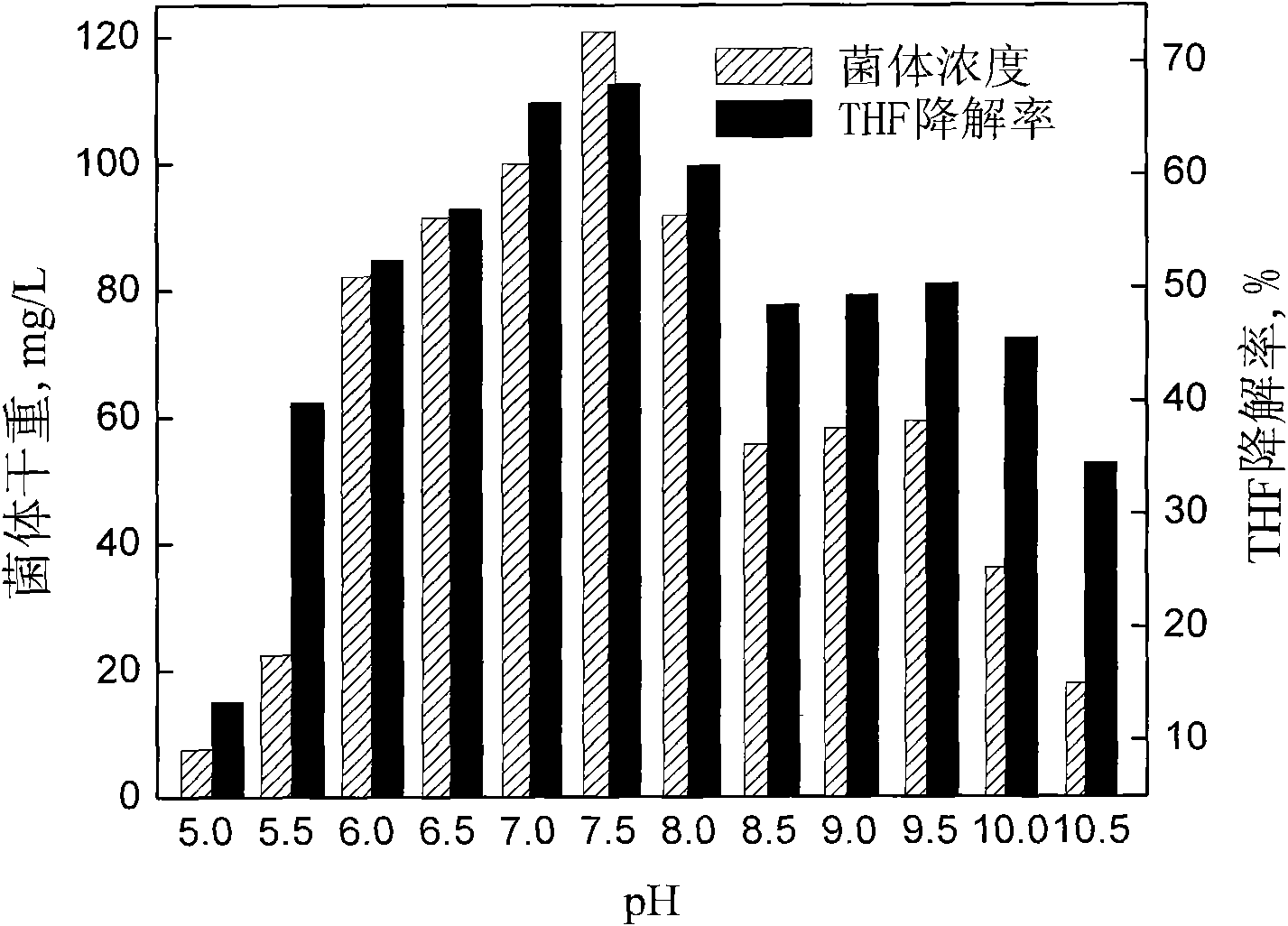Tetrahydrofuran-degrading Pseudomonas Oleovorans DT4 and applications thereof
A technology of Pseudomonas oleagines and tetrahydrofuran, which can be applied to bacteria, microorganism-based methods, water/sludge/sewage treatment, etc., and can solve the problems of long microbial generation time and low tetrahydrofuran biodegradation efficiency.
- Summary
- Abstract
- Description
- Claims
- Application Information
AI Technical Summary
Problems solved by technology
Method used
Image
Examples
Embodiment 1
[0022] Example 1: Isolation and identification of P.OleovoransDT4
[0023] (1) Sample collection and domestication
[0024] The activated sludge from the sewage treatment tank of a chemical plant in Shaoxing was collected on site, and THF was used as the only carbon source and energy source for domestication and enrichment. Several months later, the enriched activated sludge was inoculated into a 250mL sealed saline bottle containing 50mL of BSM medium, and THF was used as the only carbon source and energy source to continue the cultivation and enrichment. The experiment requires a constant temperature (30±1°C) and is kept under aerobic conditions.
[0025] BSM was formulated as follows: 4.5g Na 2 HPO 4 12H 2 O, 1.0g KH 2 PO 4 , 1.8g (NH 4 ) 2 SO 4 , 0.2g MgSO 4 ·7H 2 O, 0.03g CaCl 2 2H 2 O, 1mL trace element mother solution, make up to 1000mL with water.
[0026] Concentration composition of trace element mother liquor: FeSO 4 ·7H 2 O 1.0g / L, CuSO 4 ·5H 2 O ...
Embodiment 2
[0032] Example 2: Characteristics of THF degradation by P.Oleovorans DT4
[0033] Use THF as the sole carbon source of P.Oleovorans DT4, inoculate the bacterium from the seed solution to 50mL BSM medium, so that the initial bacterial concentration (by dry weight) is 3.2mg / L; add THF to make the initial THF concentration 5mM . Put it into a shaker with a temperature of 30°C and a rotation speed of 160r / min for cultivation, and take samples every 2 hours, see the results figure 1 . With the prolongation of time, the bacterial concentration increased gradually, and reached 275.6 mg / L (by dry weight) at 14 hours. This example shows that the degrading bacteria P.Oleovorans DT4 can use THF as the only carbon source and energy source for growth and reproduction, and has the ability to efficiently degrade THF.
[0034] Use 1mol / L NaOH or HCl solution to adjust the BSM medium to different pH values (5.0, 5.5, 6.0, 6.5, 7.0, 7.5, 8.0, 8.5, 9.0, 9.5, 10.0, 10.5), under the condition...
Embodiment 3
[0037] Embodiment 3: Degradation of benzene, toluene, ethylbenzene and xylene by P.Oleovorans DT4
[0038] Using benzene and toluene as the sole carbon source of P.Oleovorans DT4 respectively, inoculate 50mL of BSM medium with the seed liquid acclimated and cultivated in toluene, so that the initial cell concentration is 3.2mg / L, and the initial substrate (benzene or toluene ) at a concentration of 1 mM, and the degradation experiment was carried out in a shaker at 30° C. and 160 r / min. As a result, benzene and toluene were degraded completely in 18 and 24 hours respectively, as Figure 4 shown.
[0039] Add 2mM THF and 2mM ethylbenzene to 50mL BSM medium, insert P.Oleovorans DT4 bacterial solution to make the initial concentration reach 3.2mg / L (based on the dry weight of bacterial cells), and place on a shaker at 30°C and 160r / min In the degradation experiment. As a result, ethylbenzene began to be degraded when THF was completely degraded. Using the same method, P.Oleov...
PUM
 Login to View More
Login to View More Abstract
Description
Claims
Application Information
 Login to View More
Login to View More - R&D
- Intellectual Property
- Life Sciences
- Materials
- Tech Scout
- Unparalleled Data Quality
- Higher Quality Content
- 60% Fewer Hallucinations
Browse by: Latest US Patents, China's latest patents, Technical Efficacy Thesaurus, Application Domain, Technology Topic, Popular Technical Reports.
© 2025 PatSnap. All rights reserved.Legal|Privacy policy|Modern Slavery Act Transparency Statement|Sitemap|About US| Contact US: help@patsnap.com



